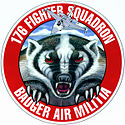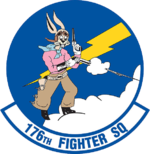| 176th Fighter Squadron | |
|---|---|
 A two ship of F-16C Fighting Falcons (87-0258, 87-260 )from the 176th Fighter Squadron, 115th Fighter Wing, Wisconsin Air National Guard on a routine training mission in the skies over Wisconsin 21 October 2008. | |
| Active | 16 July 1942-Present |
| Country |
|
| Allegiance |
|
| Branch |
|
| Type | Squadron |
| Role | Fighter |
| Part of | Wisconsin Air National Guard |
| Garrison/HQ | Truax Field Air National Guard Base, Madison, Wisconsin |
| Nickname(s) | "Badger Air Militia" |
| Tail Code | Red tail stripe "Wisconsin" in white letters, "WI" |
| Engagements | World War II |
| Insignia | |
| 176th Fighter Squadron emblem |
 |
The 176th Fighter Squadron (176 FS) is a unit of the Wisconsin Air National Guard 115th Fighter Wing located at Truax Field Air National Guard Base, Madison, Wisconsin. The 176th is equipped with the F-16 Fighting Falcon.
History[]
World War II[]
- Not to be confused with the United States Air Force 306th Tactical Fighter Squadron
- See 338th Bombardment Group for expanded World War II history
Activated in July 1942, the 306th Fighter Squadron was an advanced pilot training squadron, assigned to III Fighter Command at Dale Mabry Army Airfield, Florida. The 306th was an Operational Replacement Unit (OTU) which trained newly graduated pilots in combat fighter tactics with graduates being assigned to operational squadrons for combat in overseas theaters. Initially equipped with the P-39 Aircobra, later using P-47 Thunderbolts and P-51 Mustangs when they became available. Disbanded in May 1944 as part of a reorganization of Army Air Force training unit designations.
Wisconsin Air National Guard[]
The wartime 306th Fighter Squadron was reconstituted and re-designated as the 176th Fighter Squadron, and was allotted to the Wisconsin Air National Guard, on 24 May 1946. It was organized at Truax Field, Madison, Wisconsin and was extended federal recognition on 6 October 1948 by the National Guard Bureau. The 176th Fighter Squadron was entitled to the history, honors, and colors of the 306th. The squadron was equipped with F-51D Mustangs and was assigned to the new 128th Fighter Group, WI ANG at General Mitchell Field, Milwaukee.
Air Defense[]

176th Fighter-Interceptor Squadron F-89J 53-2686
The 176th was gained by Air Defense Command (ADC) with an air defense mission of the Great Lakes, Chicago and Wisconsin. Upgraded to F-80A Shooting Star jet aircraft in 1949. Was re-designated as the 176th Fighter-Interceptor Squadron in November 1950 and 10 of the unit's 25 Mustangs were shipped to Korea in support of the Korean War effort. Federalized during the Korean War in February 1951, but remained at Truax Field where it flew air defense training missions. During the active duty tour, the 176th FIS converted its aircraft to the F-89 Scorpion. They became the first Air National Guard unit to fly the modern jet fighter. Returned to Wisconsin state control in February 1952 and converted back to the F-51 Mustang.
In October 1953, The 176th FIS converted from F-51's to the F-86 Sabre, and the squadron performed summer training with the F-86 was at the Alpena Training Center in Alpena, Michigan in 1954. In October 1954 The 176 Fighter Squadron was reassigned the F-89 Scorpion, which they had flown briefly in 1952 during the unit's Korean War activation. The aircraft, designed as an "All Weather" fighter interceptor, carried a pilot and radar operator.

176th Fighter Interceptor Squadron Convair F-102A-75-CO Delta Dagger 56-1279 taking off from Truax Field, Wisconsin, 1970.
On 15 April 1956, the 176th FIS was authorized to expand to a group level, and the 115th Fighter-Interceptor Group was established by the National Guard Bureau at Truax Field. The 176th FIS becoming the group's flying squadron. The Group continued its air defense mission with summer training moved to Volk Field from 1956 to 1962. Beginning in 1963, training moved to "year around" training. In January 1960 F-89 crews were put on active duty status and the unit was assigned an around-the-clock runway alert commitment of two armed aircraft. Along with this commitment came the F-89J with an armament platform that included the AIR-2 Genie. The AIR-2A was the first US air to air rocket with a nuclear warhead. In early 1966 the squadron turned in their F-89's for the F-102 Delta Dagger.
In May 1966 the 176th FIS replaced their F-89's with the Convair F-102 Delta Dagger. In the spring of 1967 after a period of re-training in the new supersonic interceptors, the 176th FIS resumed its air defense "runway alert" mission. One year later in June 1969, the unit airlifted to Gulfport, Mississippi for summer training, ending six years of "year around" training at home base.
In September 1972, the 176th FIS won the prestigious "William Tell Competition" in the F-102 category. The event, held at Tyndall Air Force Base, included top Air National Guard, Canadian Air Force and active US Air Force units worldwide. The competition included 12 teams of 48 aircraft, each team scored on aerial marksmanship, weapons control, weapons loading and maintenance.
Forward Air Control[]
In November 1974, the squadrons parent 115th Fighter-Interceptor Group was transferred from Air Defense Command to Tactical Air Command(TAC). In addition the 115th's status was elevated from a group to a Wing, its designation being changed to the 128th Tactical Air Support Wing in a re-alignment by the Wisconsin National Guard Bureau. The squadron was re-designated as the 176th Tactical Air Support Squadron (TASS), and in December 1974 the unit's F-102's were replaced by the Cessna O-2A Skymaster Forward Air Control (FAC) aircraft. The O-2 was the military version of the Cessna 337 Skymaster, a high wing, twin boom aircraft with a unique centerline pusher/tractor twin engine configuration. The O-2A version, used by the 176th TASS, was used in forward air control, (FAC), missions, often in conjunction with a ground FAC & ROMAD, (radio operator, maintenance, and driver), team. In November 1979, the O-2s were replaced by the OA-37B Dragonfly Forward Air Control aircraft. It was developed from the A-37 light attack aircraft which was used extensively in the Vietnam War as a counter-insurgency aircraft, with the surviving aircraft either being sold to the South Vietnamese Air Force or returned to the United States. The OA-37s were received from ANG units in Maryland and New York.
With most of the pilots and maintenance crews having prior jet aircraft experience with the F-102's, the unit was able to transition the OA-37 to C-1 status, (full combat ready), in less than six months. Awards during the OA-37 era included an overall rating of "Excellent" in the unit's Operational Readiness Inspection (ORI), the Distinguished Flying Award and their first Air Force Outstanding Unit Award.
Close Air Support[]
On 1 October 1981, the 176th TASS was redesignated the 176th Tactical Fighter Squadron (TFS). Along with the mission change came a new aircraft, the A-10 Thunderbolt II, nickname "Warthog", with the OA-37s being sent to other ANG units. For survivability made the A-10 an excellent weapons delivery system for ground targets. The A-10's most dominant feature is its seven barrel GAU-8/A 30mm cannon, capable of firing at up to 70 "tank busting" rounds per second.
During the A-10 era the unit received two "Outstanding Unit" Awards, three Air Force Flight Safety Awards, and in 1991 an "Outstanding" in its Unit Effectiveness Inspection (UEI). Deployments with the A-10 included Operation Coronet Cove to Panama, and "Checkered Flag" missions to NATO bases in West Germany and England.
Current mission[]

USAF F-16C block 30 #87-0278 from the 176th FS sits on the runway in Madison on June 28th, 2008 during the Rhythm and Booms Fireworks display. Note the 60th Anniversary paint scheme on the tail.
With the end of the Cold War, the early 1990s marked several changes. On 16 March 1992 the 176th Tactical Fighter Squadron (TFS) was redesignated the 176th Fighter Squadron (FS) as its parent 128th Tactical Fighter Wing became the 128th Fighter Wing. The 128th FW implemented the Air Force Objective Organization, which established the 128th Operations Group to which the 176th FS was assigned. Also occurring at this time was a command change from the Air Force's Tactical Air Command (TAC) to the newly created Air Combat Command (ACC).
In 1993 the 176th FS began transitioning from the A-10A to the F-16C/D block 30 Fighting Falcon airframes with the enlarged inlet, with the A-10s were transferred out to other ANG units. The first F-16s arrived at Truax ANGB on 1 April 1993. The current role of the 176th FS is air-interdiction and close air support (CAS). This was the same task as when they flew the A-10. Although the transition to the F-16 meant a huge change in the overall execution of this mission when comparing the A-10 with an F-16. On 11 October 1995, the squadron was reassigned to the new 115th Operations Group when its parent 128th Fighter Wing was re-designated back to the 115th by the Wisconsin National Guard Bureau. The 128th designation was causing confusion with the 128th Air Refueling Wing at General Mitchell ANGB, another Wisconsin Air National Guard unit. Operations participated in during this era include: Operation Coronet Chariot, Karup AS, Denmark 1994, Operation Northern Watch, Incirlik AB, Turkey 1997, Operation Southern Watch, Al Jaber AB, Kuwait 1997-98, Operation Southern Watch, Prince Sultan AB, Saudi Arabia 1999, Operation Coronet Nighthawk, Curacao, Netherlands Antilles 2001, Operation Enduring Freedom, Al Udeid AB, Qatar 2004-05, and Operation Noble Eagle, 11 Sept. 2001 to present.
In October 2008, the squadron celebrated its 60th Anniversary.
Lineage[]

Legacy 176th Fighter Squadron Emblem

Legacy 176th Fighter-Interceptor Squadron Emblem
- Constituted 306th Fighter Squadron on 16 Jul 1942
- Activated on 22 Jul 1942
- Disbanded on 1 May 1944
- Reconstituted, re-designated 176th Fighter Squadron, and allotted to Wisconsin ANG, on 24 May 1946
- Extended federal recognition and activated 6 Oct 1948
- Re-designated: 176th Fighter-Interceptor Squadron on 1 Nov 1950
- Federalized and placed on active duty, 1 February 1951
- Released from active duty and returned to Wisconsin state control, 1 November 1952
- Re-designated: 176th Tactical Air Support Squadron on 9 Nov 1974
- Re-designated: 176th Tactical Fighter Squadron on 15 Nov 1981
- Re-designated: 176th Fighter Squadron on 15 Mar 1992
Assignments[]
- 338th Fighter Group, 22 Jul 1942-1 May 1944
- 128th Fighter Group, 29 Jun 1948
- 128th Fighter-Interceptor Group, 1 Nov 1950
- 115th Fighter-Interceptor Group, 15 Apr 1956
- 115th Tactical Air Support Group, 9 Nov 1974
- 128th Tactical Air Support Wing, 9 Nov 1974
- 128th Tactical Fighter Wing, 15 Nov 1981
- 128th Operations Group, 15 Mar 1992
- 115th Operations Group, 11 Oct 1995
Stations[]
- Dale Mabry Army Airfield, Florida, 22 Jul 1942-1 May 1944.
- Truax Field, Wisconsin, 6 Oct 1948
- Designated: Truax Field Air National Guard Base, Wisconsin, 1991 – present
Aircraft[]
|
|
References[]
This article incorporates public domain material from the Air Force Historical Research Agency website http://www.afhra.af.mil/.
- A Handbook of Aerospace Defense Organization 1946 - 1980, by Lloyd H. Cornett and Mildred W. Johnson, Office of History, Aerospace Defense Center, Peterson Air Force Base, Colorado
- Maurer, Maurer. Combat Squadrons of the Air Force: World War II. Maxwell Air Force Base, Alabama: Office of Air Force History, 1982.
- 115th Fighter Wing official site (Archived 2009-07-27)
- Rogers, B. (2006). United States Air Force Unit Designations Since 1978. ISBN 1-85780-197-0
- 115th Fighter Wing website history
- 115th Fighter Wing@globalsecurity.org
| |||||||||||||||||||||||||||||||||||||
The original article can be found at 176th Fighter Squadron and the edit history here.
